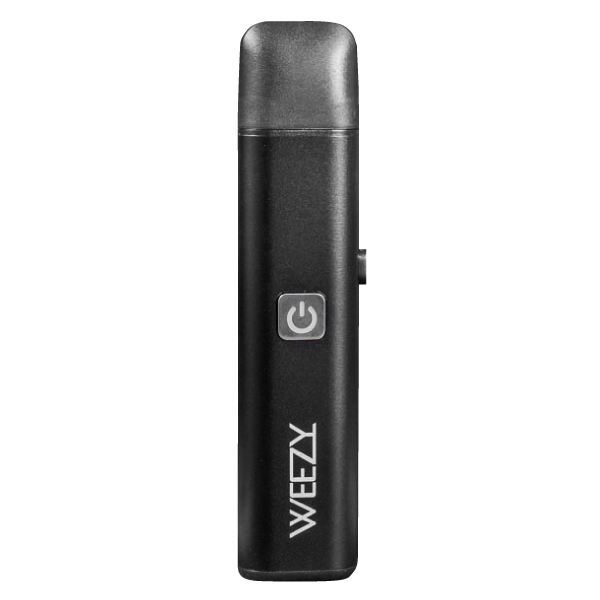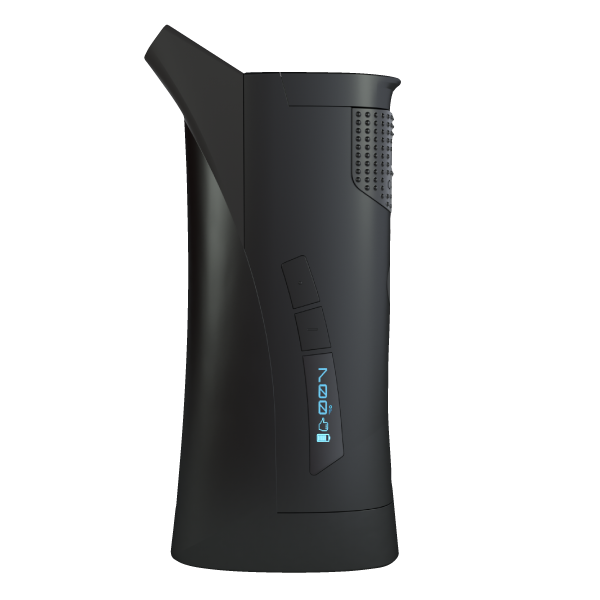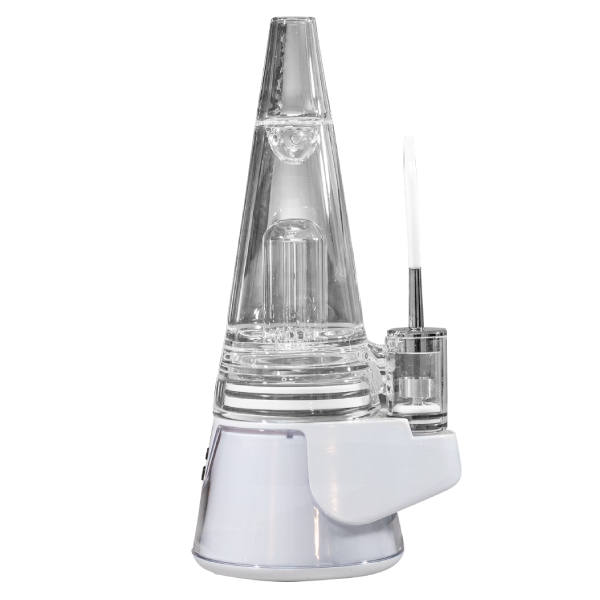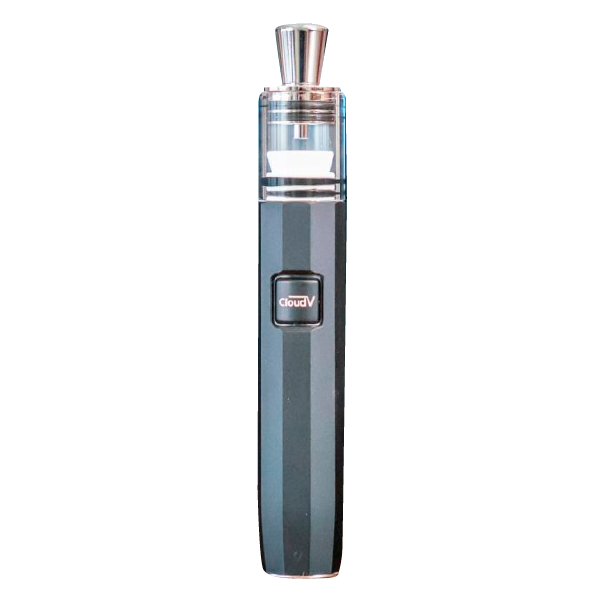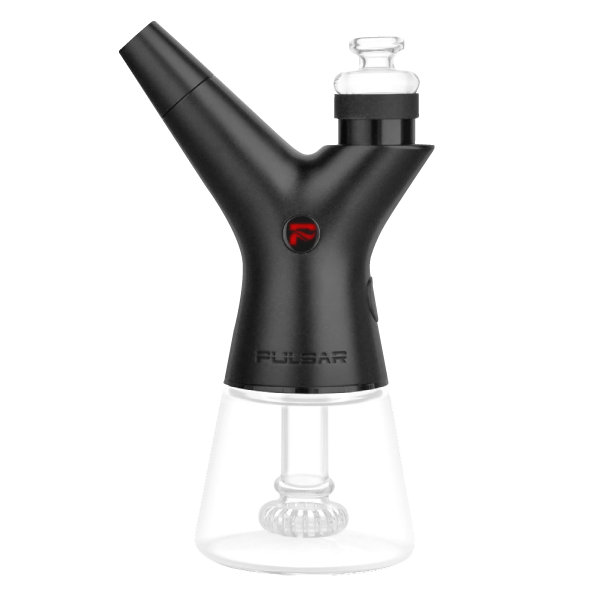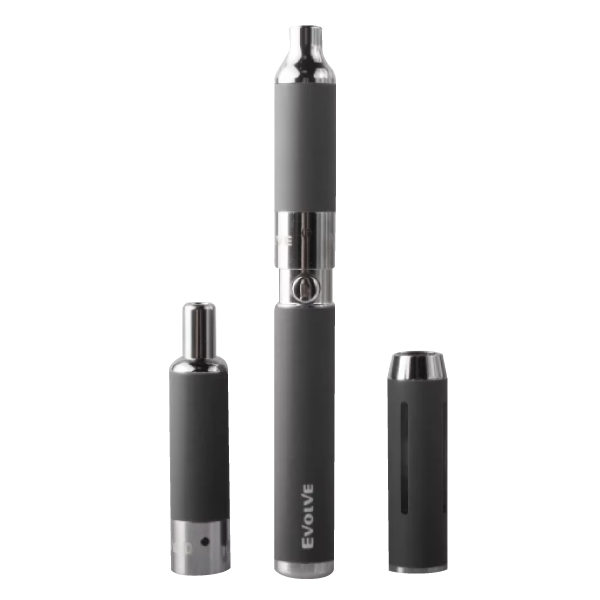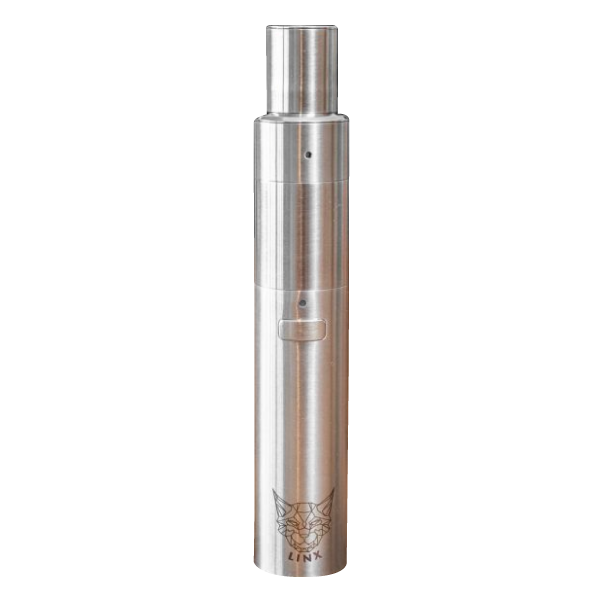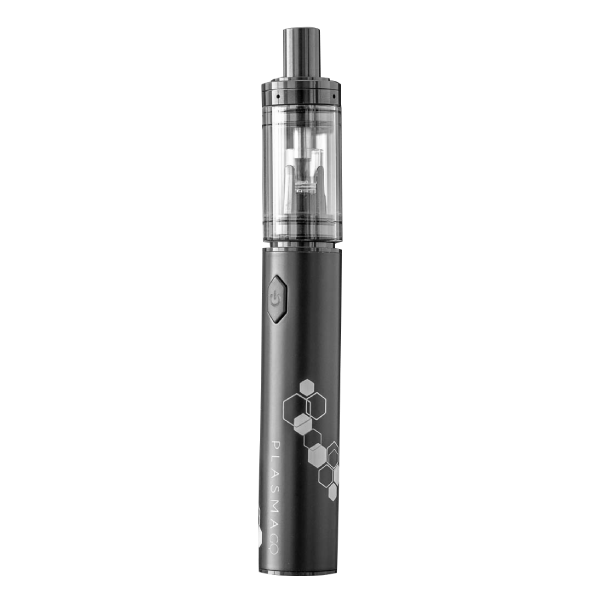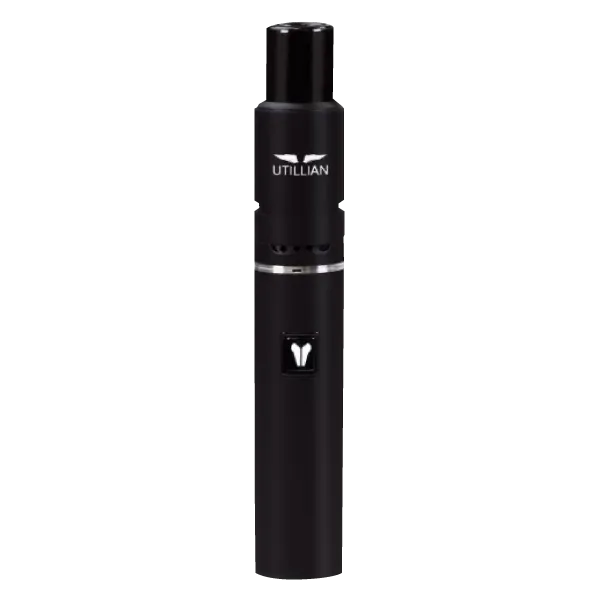What Are Concentrate Vaporizers
Concentrate vaporizers, often referred to as ‘wax vapes’ or ‘dab vapes,’ are devices designed to vaporize cannabis extracts, such as hash, rosin, resin, wax, dab, shatter, and budder.
These devices usually consist of a battery, a heating element (such as a coil or chamber), and a mouthpiece (with or without water filtration). The heating element heats the concentrate to a point just below combustion (typically around 450°F), releasing its active compounds in a clean, potent vapor.
Related: Best concentrate vaporizers of 2024
Types of Concentrate Vaporizers
Dab Pens
Dab Pens, aka wax pens, are the most portable and discreet option among concentrate vaporizers. They resemble writing pens in size and shape. Users load a small amount of concentrate onto the coil, which heats up to vaporize the material.
- Pros: Highly portable, simple to use, discreet, and generally more affordable.
- Cons: Smaller size may mean less battery life and a smaller heating chamber.
Nectar Collectors
Nectar Collectors, aka honey straws, are a unique type of extract vaporizer. They are used by heating the tip and then directly touching it to the concentrate while inhaling through the other end.
- Pros: Offer a more direct and controlled dabbing experience. No need to reload the coil and there is minimal waste of concentrates. They are also portable and simple to use.
- Cons: You’d have to carry the wax jar with you, and they can be less precise in dosage control.
E-nails/E-rigs
Electronic nails (e-nails) and electronic rigs (e-rigs) are more technologically advanced options. These devices often provide precise temperature control and are better suited for home use. eRigs are complete systems with the water bubbler and the heating element, and E-nails include only the heating element that can be attached to traditional dab rigs, replacing the need for a torch and nail.
- Pros: Consistent and controlled experience, allows use of water filters, ideal for low-temp dabbing, and offers a more robust experience.
- Cons: Generally more expensive and less portable than other options.
Dry Pipes
Dry pipes are a hybrid between wax pens and eRigs. They are concentrate vaporizers that do not look like a pen and do not have a water filter (but may be compatible with one.)
- Pros: Simple and straightforward to use, better performance than a dab pen, more portable than a dab rig.
- Cons: It requires more cleaning and maintenance than dab pens.
Vapor Cups
Vapor cups are a niche category in concentrate vaporizers that is fairly new but has been very exciting so far. They are designed as a “cup” that is attached to a heating element and a pump that fills the cup with vapor at the press of a button. The vapor can then be “sipped” on demand.
- Pros: Provides a clean and controlled way to vaporize concentrates, has a “wow” effect when the vapor fills the cup, and is very approachable for newbies.
- Cons: Typically more expensive, not portable.
Types of concentrates
Understanding the different types of cannabis concentrates is crucial for choosing the right extract for your vaporizer. Here’s a breakdown of the various forms they come in:
- Resin: Resin, or live resin, is made from fresh, frozen cannabis plants, preserving a more robust terpene profile. It’s highly aromatic and flavorful.
- Dab/Wax: These are soft, opaque concentrates that are easy to handle and dose. Dabs and waxes are known for their potent flavors and high cannabinoid content.
- Crumble: Crumble is a drier form of wax that, as the name suggests, has a crumbly texture. It’s easy to dose but can be difficult to handle due to its consistency.
- Rosin: Rosin is a “solventless” extract made using mechanical pressure to extract the resin from cannabis flowers or hash. Solventless is considered the purest type of extract, making it popular among health-conscious users.
Concentrates vs. Oil Cartridges
Oil Cartridges: These are pre-filled with cannabis oil and are used with 510-thread batteries. They’re incredibly convenient, easy to use, and ideal for discreet consumption. However, they don’t offer the same level of potency or flavor depth as solid concentrates.
Concentrates: These “solid extracts” are the ones we’re focused on here. They come in a 1gr container and offer a more hands-on approach to vaping, appealing to more advanced users.
Buying from Licensed Dispensaries
Regardless of the type of concentrate you’re using, purchasing from licensed dispensaries ensures that the products have been tested for purity and potency, adhering to safety standards. Official dispensaries operate within the legal framework, ensuring that the products you buy are legal and compliant with state regulations. Plus, they offer a wide variety of products and can provide expert advice on choosing the right concentrate for your needs and experience level.
Types of coils
The type of coil (or chamber) plays a critical role in the quality of the vapor produced. The heating chambers of wax vaporizers are typically made from Ceramic or Quartz, but more important than their material is their shape:
Bowl vs. Rods
- Bowl: These have a dish-like shape where the concentrate is placed directly into the bowl.
- Pros: Even heating, easier to clean, better for low-temperature dabs, and generally offers a purer flavor.
- Cons: It might not be intense enough for some users.
- Rod Coils: These use one or more rods, usually wrapped in a heating wire, where the concentrate is applied.
- Pros: Rod coils heat up quickly and offer a potent experience, good for high-temp dabbing.
- Cons: Needs slightly more cleaning, higher temperatures can affect the flavor.
Ceramic vs. Quartz
The choice between these coil types often comes down to personal preference and vaping style. If you prioritize flavor and a smooth experience, ceramic bowls might be your go-to. If you prefer quick heating and intense vapor, quartz could be more suitable.
Temperature Control Matters
Different cannabinoids and terpenes vaporize at different temperatures. Precise temperature control allows targeting specific compounds, significantly affecting the flavor profile and overall experience.
- Low-Temperature Dabbing: Ideal for flavor enthusiasts, low-temperature dabbing (around 380°F to 450°F) preserves delicate terpenes, providing a richer, more nuanced taste.
- High-Temperature Dabbing: Higher temperatures (above 450°F) produce more robust vapor and more intense effects but can diminish flavor quality and burn off terpenes.
Health and Safety Considerations
- Avoiding Combustion: One of the primary health benefits of vaporizing concentrates is avoiding the harmful byproducts of combustion that occur when smoking. Proper temperature control ensures that concentrates are vaporized, not burned.
- Reduced Toxins: Lower temperatures reduce the risk of inhaling harmful toxins. Some studies suggest that vaporizing at controlled, lower temperatures can reduce the inhalation of potentially harmful substances.
- Throat and Lung Irritation: High temperatures can cause harsh vapor, leading to throat and lung irritation. Using lower temperatures can result in a smoother, more comfortable experience, especially for users with respiratory sensitivities.
Temperature control in concentrate vaporizers is not just a feature; it’s a critical aspect that enhances the overall vaping experience. It allows for a tailored experience where users can adjust settings to suit their flavor preferences, desired effects, and health considerations.
Dry Herb vs. Concentrate vaporizers
Unlike extracts, which only contain the plant’s oils, dry herb includes fiber as well (and it has to be discarded at the end of each session.) Dry herb vaporizers are typically more robust and complicated than extract vapes. Vaporizing dry herbs also involves extracting them from the fiber.
Here are some other notable differences:
- Temp range- herb vaporizers work best at temps around 370-400°F. Concentrate vapes work at higher temps of around 450-600°F
- Session duration- herb vapes typically keep heat active for long sessions (~5 minutes), during which the herb gets “baked.” Concentrate vapes only heat up for 10-20 seconds at a time.
- Chamber vs. coil- The chamber of dry herb vapes is different from the coils and bowls used for concentrates.
Concentration vapes are known for delivering a more intense experience than traditional dry herb vaping, both in terms of flavor and the effects of cannabinoids and terpenes.
Smoking vs. Vaping Concentrates
When comparing smoking and vaping concentrates, the key differences lie in the method of heat application and the resultant byproducts.
Smoking involves direct combustion, where the material is burned at high temperatures, leading to the creation of smoke. This smoke contains a mix of compounds, including various cannabinoids and terpenes from the concentrate, but also harmful byproducts like tar, benzene, and carbon monoxide. These byproducts are a result of the high-temperature combustion process, which can reach over 1000°F, far exceeding the vaporization points of most cannabinoids and terpenes.
In contrast, vaping uses lower temperatures to heat concentrations just enough to turn them into vapor without reaching the point of combustion. This process typically occurs at temperatures between 400°F and 500°F, which is sufficient to vaporize the active compounds without producing many of the harmful substances associated with smoking.
The implications of these differences are significant, both in terms of health and user experience. From a health perspective, vaping is generally considered to be less harmful than smoking, as it reduces the user’s exposure to toxic byproducts of combustion. In terms of experience, vaping tends to deliver a more flavorful and potent experience, as the lower temperatures preserve the delicate terpenes responsible for the aroma and flavor of the concentrates.
Additionally, vaping provides a more controlled and customizable experience, as many vaporizers offer adjustable temperature settings. This allows users to tailor their sessions based on their desired balance of flavor intensity, vapor density, and physical effects.
Accessories and Add-ons
There are two accessories that I recommend regardless of which concentrates vaporizer you use:
- Hot knife– A hot knife is a dab tool that heats up the tip so the dab can melt and slide down into the coil with a press of a button. Most concentrates are super sticky and can be challenging (and messy) to handle. A typical dab tool allows you to pick up the dab easily, but there is no way to drop it into the bowl. And the last thing you want is to scrape it on the side of the bowl- it will clog things up and substantially reduce your efficiency.
- Dab swabs– Use these to mop your bowl at the end of each session to prevent residue from building up and accumulating in the coil.
FAQs
Can you use dry herb in a concentrate vaporizer?
No. Concentrate vaporizers are designed to heat and vaporize denser, more resinous materials. These devices operate at higher temperatures (~500F) than those required for dry herbs (~380F). Using dry herb in a concentrate vaporizer will most likely burn the herb. Additionally, it can cause damage to the vaporizer. Some vaporizers are designed as hybrid models that are compatible with both concentrates and dry herbs, so these are okay to use in the designated setting.
What's the best temperature for dabbing?
The best temperature for dabbing concentrates like waxes, resin, and hash typically ranges between 400°F to 550°F. Lower temperatures within this range produce a flavorful and smooth vapor, as they preserve the delicate terpenes and avoid burning the concentrate. Low-temp dabbing is ideal for taste with a less intense throat hit. Higher temps produce intense vapor and a stronger effect, as more cannabinoids are vaporized. However, this may come at the cost of flavor and can result in a harsher vapor. The ideal temperature for dabbing can vary depending on personal preference and the specific characteristics of the concentrate being used. Experimenting within this range is recommended to find the sweet spot that suits your preferences for flavor and potency.
